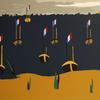Frank Weston Benson (American 1862 - 1951)
- April 20, 2022 09:54
Born in Salem, Massachusetts Frank Weston Benson’s father taught him to navigate the marshes, streams, and wetlands of Massachusetts’ North Shore, where he spent many weekends watching birds, hunting waterfowl or fishing. In 1880 Benson enrolled in School of the Museum of Fine Arts in Boston, studying under Otto Grundmann, followed by study at Academie Julian under Gustave Boulanger, William Turner Dannat, and Jules-Joseph Lefebvre from. In the summer of 1884 Benson painted at Concarneau, on the Brittany coast of France, alongside Willard Metcalf and Edward Simmons. Back in the United States in 1885, Benson taught at the Maine College of Art. In 1886 he opened a studio in Salem with his friend, artist Phillip Little. From 1889 to 1893, 19th century artist Frank Benson spent his summers at the Dublin, New Hampshire, art colony near the Mount Monadnock. It was here that Benson came under the influence of Impressionist painter, Abbot Thayer. Throughout most of the 1890s and into the early 1900s, Benson concentrated on landscapes, often including family members, and maritime paintings, executed in an impressionist style. In 1898 Benson and nine other artists formed "Ten American Painters". Circa 1914 he began producing wildlife etchings and was a founding member of the Guild of Boston Artists. From 1921 on, he focused on watercolor painting which he continued until his death in 1951. In 1935 was Benson chosen to design the Federal Duck Stamp. Benson exhibited at the Royal Academy (London, 1885); National Academy of Design (New York, Hallgarten Prize, 1890, Thomas B. Clark Prize, 1891, Thomas R. Proctor Prize, 1906); Chase Gallery (Boston, 1891); The Ten American Painters (New York City); Society of American Artists (1896, Shaw Fund Prize); Paris Exposition Universelle (1900, silver medal); Carnegie Museum of Art (1903, Carnegie Prize); Art Institute of Chicago, 1922 and 1924); Copley Society of Art ( Boston, 1913); The Guild of Boston Artists (1915); George Gage Gallery (Cleveland, Ohio, 1915); Kennedy Galleries (New York City, 1915); British Museum (London, 1916); Arthur Harlow & Sons Gallery (New York City, 1945); and the Pennsylvania Academy of the Fine Arts (Philadelphia, Pennsylvania, 1950).













![Peter Paul Rubens (Flemish, 1577–1640), After Titian (Tiziano Vecelli) (Italian [Venetian], c. 1488–1576), Rape of Europa, 1628–29. Oil on canvas, 71 7/8 x 79 3/8 in. Peter Paul Rubens (Flemish, 1577–1640), After Titian (Tiziano Vecelli) (Italian [Venetian], c. 1488–1576), Rape of Europa, 1628–29. Oil on canvas, 71 7/8 x 79 3/8 in.](/images/c/e2/2e/Jan20_Rape_of_Europa100x100_c.jpg)
__2016_100x100_c.jpg)






